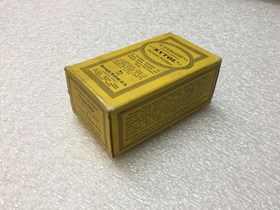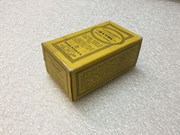Narrow Results By
Auto Transformer
https://archives.whyte.org/en/permalink/artifact104.41.0110
- Date
- 1950 – 1970
- Material
- metal; plastic
- Catalogue Number
- 104.41.0110
- Description
- Rectangular metal box with rubber knobs on the bottom to keep it off of tabletops, a 0-100 dial, pale yellow circular button, and red light on the top, and four different plugs across the two short sides - one side has one and the other has three. There is a circular hole in the bottom that allows …
1 image
- Title
- Auto Transformer
- Date
- 1950 – 1970
- Material
- metal; plastic
- Dimensions
- 13.5 x 15.1 x 12.6 cm
- Description
- Rectangular metal box with rubber knobs on the bottom to keep it off of tabletops, a 0-100 dial, pale yellow circular button, and red light on the top, and four different plugs across the two short sides - one side has one and the other has three. There is a circular hole in the bottom that allows some limited access to the interior, possibly a vent. Variable Autotransformers are used to control electrical voltage, power, and current so as to provide a safe and steady electrical feed to a device.
- Credit
- Gift of Nicholas Morant, Banff, 2006
- Catalogue Number
- 104.41.0110
Images
This material is presented as originally created; it may contain outdated cultural descriptions and
potentially offensive content.
Read more.
- Date
- 1960 – 1980
- Material
- metal; plastic; paper; glass;
- Catalogue Number
- 104.41.0119 a-g
- Description
- Rectangular shiny silver metal box with a lift-off lid. Contents of the box include two glass vignettes with edges wrapped in pale brown binding tape [one has a small tab on one side], a yellow-tinted “KODAK SERIES VI ADAPTER RING” mounted in metal, a circular black plastic “CRAFTMEN’S GUILD PICTOR…
1 image
- Title
- Equipment Box
- Date
- 1960 – 1980
- Material
- metal; plastic; paper; glass;
- Dimensions
- 5.1 x 11.7 x 21.0 cm
- Description
- Rectangular shiny silver metal box with a lift-off lid. Contents of the box include two glass vignettes with edges wrapped in pale brown binding tape [one has a small tab on one side], a yellow-tinted “KODAK SERIES VI ADAPTER RING” mounted in metal, a circular black plastic “CRAFTMEN’S GUILD PICTORAL CONTROL” fixture with a clear central hole, a thin grey cardboard Kodak box with a strip of paper adhesive tape wrapped around the box holding the lid closed that has “2 1/4 x 3 1/4 Glasses for A - Assembly Enlarger” in blue ink [most likely written by Morant], a second thin Kodak cardboard box with a paper adhesive tape on the lid that has “MASKS for PRECISION A” written in black ink [probably by Morant] that contains wax paper envelopes of coloured celluloid masks, and a paper Canadian Pacific Railway envelope that contains wax paper envelopes of coloured celluloid masks.
- Credit
- Gift of Nicholas Morant, Banff, 2006
- Catalogue Number
- 104.41.0119 a-g
Images
This material is presented as originally created; it may contain outdated cultural descriptions and
potentially offensive content.
Read more.
Magnifying Glass
https://archives.whyte.org/en/permalink/artifact104.38.0019
- Date
- 1950 – 1970
- Material
- metal; glass; plastic; wood
- Catalogue Number
- 104.38.0019
- Description
- Articulated magnifying glass with a black plastic base mounted on a piece of wood.
1 image
- Title
- Magnifying Glass
- Date
- 1950 – 1970
- Material
- metal; glass; plastic; wood
- Dimensions
- 50.0 x 11.5 x 17.8 cm
- Description
- Articulated magnifying glass with a black plastic base mounted on a piece of wood.
- Credit
- Gift of Nicholas Morant, Banff, 2006
- Catalogue Number
- 104.38.0019
Images
This material is presented as originally created; it may contain outdated cultural descriptions and
potentially offensive content.
Read more.
Mounting Tissue
https://archives.whyte.org/en/permalink/artifact104.41.0135
- Date
- 1940 – 1960
- Material
- paper; cardboard
- Catalogue Number
- 104.41.0135
- Description
- One cardboard box of Kodak Dry Mounting Tissue, used to bind a print to a mounting surface such as a board by using a hot press. According to the instructions on the box, a sheet of tissue is to be trimmed to match the size of the print and then placed into a dry mounting heat press with the tissue…
1 image
- Title
- Mounting Tissue
- Date
- 1940 – 1960
- Material
- paper; cardboard
- Dimensions
- 1.8 x 21.6 x 26.8 cm
- Description
- One cardboard box of Kodak Dry Mounting Tissue, used to bind a print to a mounting surface such as a board by using a hot press. According to the instructions on the box, a sheet of tissue is to be trimmed to match the size of the print and then placed into a dry mounting heat press with the tissue between the print and the surface it is being mounted to. Once in place, the hot press applies heat and pressure, fusing the print to the mount without the use of liquid adhesives, which might create rippling.
- Credit
- Gift of Nicholas Morant, Banff, 2006
- Catalogue Number
- 104.41.0135
Images
This material is presented as originally created; it may contain outdated cultural descriptions and
potentially offensive content.
Read more.
Photograph Developer
https://archives.whyte.org/en/permalink/artifact104.41.0203
- Date
- 1880 – 1940
- Material
- cardboard;
- Catalogue Number
- 104.41.0203
- Description
- Empty cardboard box of Burroughs Wellcome & Co. ‘Tabloid’ (Photographic) ‘Rytol’ Universal Developer that could be used on plates, film, bromide and gaslight papers, and glass lantern slides. Directions on how to use the developer are printed in black throughout the yellow box. Developers were eith…
1 image
- Title
- Photograph Developer
- Date
- 1880 – 1940
- Material
- cardboard;
- Dimensions
- 9.0 x 4.0 x 5.1 cm
- Description
- Empty cardboard box of Burroughs Wellcome & Co. ‘Tabloid’ (Photographic) ‘Rytol’ Universal Developer that could be used on plates, film, bromide and gaslight papers, and glass lantern slides. Directions on how to use the developer are printed in black throughout the yellow box. Developers were either chemical powders or liquids that would be added to another agent [usually a bath] to create a solution that would then be used to expose the positive photograph after it had been transferred from the original negative. Different concentrations or chemicals used could yield different results, usually in regards to contrast and colour of the finished image, depending on the photographic base.
- Credit
- Gift of Robert Crosby Family, Banff, 1998
- Catalogue Number
- 104.41.0203
Images
This material is presented as originally created; it may contain outdated cultural descriptions and
potentially offensive content.
Read more.
Photographic Enlarger
https://archives.whyte.org/en/permalink/artifact104.41.0109
- Date
- 1950 – 1970
- Material
- metal; paper; cardboard
- Catalogue Number
- 104.41.0109
- Description
- “EXPOSURE METER BRACKET A for KODAK Precision ENLARGER” in original two-part grey cardboard box. There are several strips of masking tape along the edges of the box lid, as well as a small piece of paper adhered to one side that has “ENLARGER METER HOLDER” hand-written on the side in black ink, mos…
1 image
- Title
- Photographic Enlarger
- Date
- 1950 – 1970
- Material
- metal; paper; cardboard
- Dimensions
- 7.2 x 11.7 x 15.2 cm
- Description
- “EXPOSURE METER BRACKET A for KODAK Precision ENLARGER” in original two-part grey cardboard box. There are several strips of masking tape along the edges of the box lid, as well as a small piece of paper adhered to one side that has “ENLARGER METER HOLDER” hand-written on the side in black ink, most likely by Morant. The bracket consists of a frame with two circular openings with a matching frame that slides back and forth. One side of the enlarger has a triangular frame that holds a mirror at a 45 degree angle.
- Credit
- Gift of Nicholas Morant, Banff, 2006
- Catalogue Number
- 104.41.0109
Images
This material is presented as originally created; it may contain outdated cultural descriptions and
potentially offensive content.
Read more.
- Date
- 1908 – 1908
- Material
- cardboard;
- Catalogue Number
- 104.41.0202
- Description
- Empty cardboard box of Kokak Solio Toning and Fixing Powder cartridges with manufacturer and product details printed throughout the white box in red and black. Toning powders were chemical compounds designed to react with the emulsion layers of positive photographs that altered the tone (or colour)…
1 image
- Title
- Solio Powder
- Date
- 1908 – 1908
- Material
- cardboard;
- Dimensions
- 2.2 x 10.2 x 8.8 cm
- Description
- Empty cardboard box of Kokak Solio Toning and Fixing Powder cartridges with manufacturer and product details printed throughout the white box in red and black. Toning powders were chemical compounds designed to react with the emulsion layers of positive photographs that altered the tone (or colour) of the image, usually turning a standard black-and-white image into warmer shades of red, brown, and/or purple - sepia is a very common tone. Additionally, toning powders could be combined with a fixing agent that stabilized the emulsion layer to prevent it breaking down or fading, flaking off, or otherwise ruining the image as it set.
- Subject
- Crosby family
- Abegweit
- photography
- photographic equipment
- chemicals
- photograph development
- Kodak;
- Credit
- Gift of Robert Crosby Family, Banff, 1998
- Catalogue Number
- 104.41.0202
Images
This material is presented as originally created; it may contain outdated cultural descriptions and
potentially offensive content.
Read more.
Texture Screen
https://archives.whyte.org/en/permalink/artifact104.41.0133
- Date
- 1940 – 1960
- Material
- paper; plastic;
- Catalogue Number
- 104.41.0133
- Description
- Various different texture screens made by Agfa, Jack Powell, and Halie (Czech Republic) housed in individual paper envelopes. Texture screens were used during the photograph development process where the emulsion would be laid directly onto the screen (which is made of thin patterned plastic) to tr…
1 image
- Title
- Texture Screen
- Date
- 1940 – 1960
- Material
- paper; plastic;
- Dimensions
- 3.3 x 29.0 x 37.5 cm
- Description
- Various different texture screens made by Agfa, Jack Powell, and Halie (Czech Republic) housed in individual paper envelopes. Texture screens were used during the photograph development process where the emulsion would be laid directly onto the screen (which is made of thin patterned plastic) to transfer the pattern directly into the emulsion layer - most often used for advertisements.
- Credit
- Gift of Nicholas Morant, Banff, 2006
- Catalogue Number
- 104.41.0133
Images
This material is presented as originally created; it may contain outdated cultural descriptions and
potentially offensive content.
Read more.
















